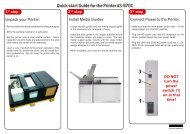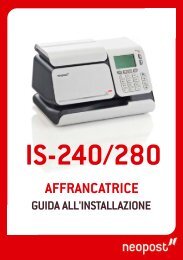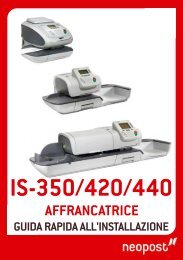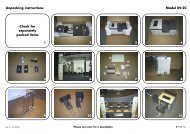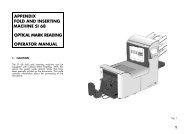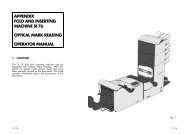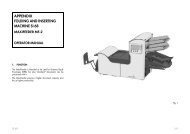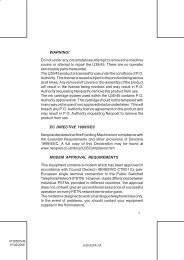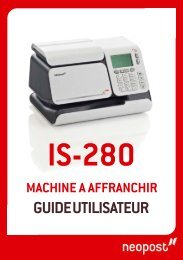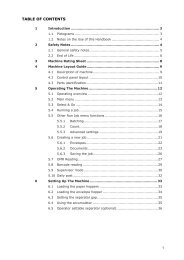User Guide Product(range) - Neopost
User Guide Product(range) - Neopost
User Guide Product(range) - Neopost
Create successful ePaper yourself
Turn your PDF publications into a flip-book with our unique Google optimized e-Paper software.
Code position and free areaThe code must be printed minimally 15 mm(0.59 inch) away from top and 30 mm (1,18inch) from the bottom of the sheet. Default thefirst mark from the top is set to 100 mm (3.9inch). From the left hand and right hand side 7mm (0.28 inch) must be kept clear. The codemust appear in the same location, and have aconsistent number of marks on every page.LengthAbove the first mark and below the last mark aspace of 8,5 mm (0.33 inch) must be keptwithout printing. This means that the minimumcode area consists of 6 lines, 2 lines to print the(basic) and 4 lines free space. Line distancemay be 2,54 mm (0.1 inch) to 6,35 mm (0.4inch).Code width, character space and pitchThe minimum width of the code area is 7character spaces. From left to right: first 2characters space unprinted (5 mm; 0.20 inch),then the track mark (3 characters or 6,3 mm; 0.4inch) and finally 2 character spaces unprinted.Pitch 10 or 12 is accepted. The track mark canbe printed by using the “underline” sign (__),which must have a thickness of at least 0,2 mm.Parity markBy adding a parity mark the reading code can bechecked. When the OMR-2 code is used thesum of the marks has to be even.Safety markThe safety mark is used as an extra security.With skewed paper the reading head can misspart of the reading code. In these situations thesafety mark is not read, and the system will givean error. The safety mark also indicates the endof the reading code. This mark always has to beprinted on the document if it has been activated.Criteria:• the marks chosen are always used in theabove sequence,• if a function is suppressed the followingfunction will move upwards one line,• the chosen code is used on all material whichwill be processed by the Optical MarkReading,• the length of the code with it's mark definitionis a service setting.7. FAULT FINDING7.1 GeneralIn the system the following error types arepossible:• paperflow errors,• reading errors (when the system is equippedwith Optical Mark Reading),• technical errors.If an error occurs the display shows a screenwith an error description and a suggestedsolution.When a paperflow error occurs the followingfunctions are available:• show more information,• reset the error after solving the problem (theerror screen will disappear).The black arrow or a black feeder indicateswhere the problem occurs.When a reading or double feed control erroroccurs, the document stops in the collator area.The operator must remove the document(s) fromthe collator area and must complete the setmanually!When there is a technical problem the displayshows a message. The error cannot be solvedby operating personnel and assistance of theservice support is needed.First write down the error code, then switch theinserter off and on again, to verify system operation.When the error still occurs contact your serviceorganization.ENGLISH19





